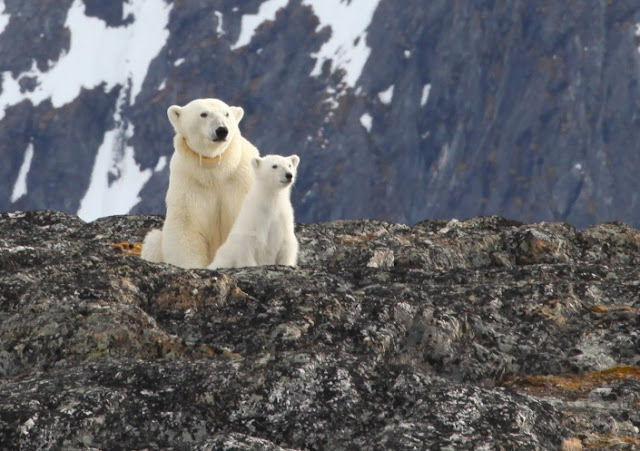It was obvious that we were headed to an "Ice Age" as we entered Svalbard, also known as Spitzbergen after its largest island.
Great views from our 757 jet of an icy lanscape
This the Common Eider
Eider down is some of the best down for insulation and locals are allowed to pick this up for market after the nesting season.
The sign reads, "Svalbard delights all" but the meaning is that polar bears can be encountered anywhere - protect yourself when going out in the country.
Svalbard is the location of the Global Seed Vault, where important seeds are stored to insure against global losses of any cause.
These are Paleocene (about 55 Ma) sediments that are rich in leaf fossils and coal deposits. The earth's climate was about 15º F warmer then than it is now, meaning that high latitude lands like Svalbard were warm and humid.
Sailing out of Isfjorden to the west and the open Atlantic. The latitude here is about 78º 30'.
A large whale was spotted on the first night
With a blow nearly 30 feet high, it could only be one kind - our planets largest animal, the Blue whale.
It is a magnificent creature
Sailing into Magdalena Fjord on our first morning
A classic U-shaped valley with a nunatak in the middle of it
Harbor seals were spotted near Danskoya (Danish Island)
They were quite curious of our Zodiac boats
After dinner, we came quite close to a mother polar bear and her 5-month old cub
I was able to get some good shots. Note that she is wearing a collar as part of a population study.
These animals have been protected from all hunting since 1973 but loss of habitat is a concern as the sea ice shrinks
Polar bears are closely related to brown bears, especially the Kodiak bear. They likely evolved from them during the Pleistocene.
This cub will likely stay with its mother another winter in the den and then make out on its own in about nine months time.
It was really special to watch them for 1/2 an hour
In Widjefjorden we saw an outcrop of the Old Red Sandstone. This is one the most well-known rock units, even for North Americans, as its fluvial origin entails many important aspects of depositional geology. It was a real treat for me to see it here in Svalbard.
The glaciers edge and the erratic boulders that fell from it
A thick fog envelopes the Sea Adventurer
A deck Bar-B-Q while at anchor in a frosty bay
We made our first landing on Spitzbergen at a place called Alkhornet
The tundra was quite soft and soggy, making walking a little difficult
Curious reindeer
They came really close as they have no land predators
Male reindeer
These are Neo-Proterozoic meta-sediments that are about 930 Ma
Close-up of the quartz-filled fractures
Buttercup flowers
Purple saxifrage
Even thought there is not one tree on Svalbard, much driftwood from Siberia makes its way to these islands
Across we spotted a large herd (or pod) of walrus
The males all congregate on the western side of the islands this time of year, while the females are on the eastern side.
They can weight up to 4,000 lbs.!
We got to within about 50 meters of them
No sparring was observed this time but they were big!
It's on to Iceland now









































No comments:
Post a Comment
If your comment will not post, email me with the problem.